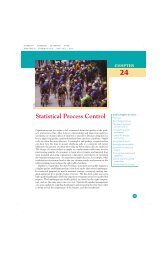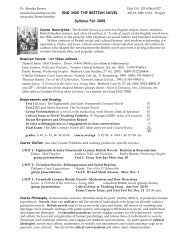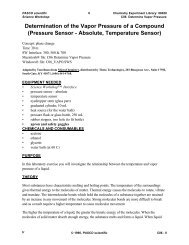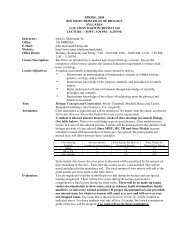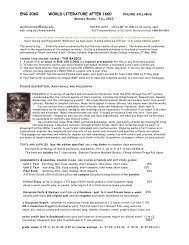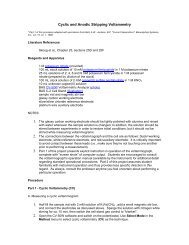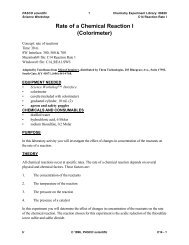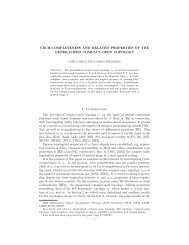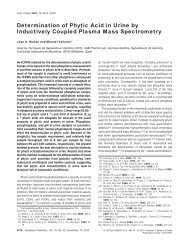CHAPTER 27 ⢠Statistical Process Control
CHAPTER 27 ⢠Statistical Process Control
CHAPTER 27 ⢠Statistical Process Control
You also want an ePaper? Increase the reach of your titles
YUMPU automatically turns print PDFs into web optimized ePapers that Google loves.
<strong>27</strong>-12 <strong>CHAPTER</strong> <strong>27</strong> • <strong>Statistical</strong> <strong>Process</strong> <strong>Control</strong><br />
MONITORS<br />
EXAMPLE <strong>27</strong>.3 Manufacturing computer monitors<br />
A manufacturer of computer monitors must control the tension on the mesh of<br />
fine vertical wires that lies behind the surface of the viewing screen. Too much<br />
tension will tear the mesh, and too little will allow wrinkles. Tension is measured<br />
by an electrical device with output readings in millivolts (mV). The manufacturing<br />
process has been stable with mean tension <strong>27</strong>5 mV and process standard<br />
deviation 43 mV.<br />
The mean <strong>27</strong>5 mV and the common cause variation measured by the standard<br />
deviation 43 mV describe the stable state of the process. If these values are not satisfactory—for<br />
example, if there is too much variation among the monitors—the manufacturer<br />
must make some fundamental change in the process. This might involve buying<br />
new equipment or changing the alloy used in the wires of the mesh. In fact, the common<br />
cause variation in mesh tension does not affect the performance of the monitors.<br />
We want to watch the process and maintain its current condition.<br />
The operator measures the tension on a sample of 4 monitors each hour. Table <strong>27</strong>.1<br />
gives the last 20 samples. The table also gives the mean x and the standard deviation<br />
s for each sample. The operator did not have to calculate these—modern measuring<br />
TABLE <strong>27</strong>.1 Twenty control chart samples of mesh tension<br />
(in millivolts)<br />
SAMPLE<br />
STANDARD<br />
SAMPLE TENSION MEASUREMENTS MEAN DEVIATION<br />
1 234.5 <strong>27</strong>2.3 234.5 <strong>27</strong>2.3 253.4 21.8<br />
2 311.1 305.8 238.5 286.2 285.4 33.0<br />
3 247.1 205.3 252.6 316.1 255.3 45.7<br />
4 215.4 296.8 <strong>27</strong>4.2 256.8 260.8 34.4<br />
5 3<strong>27</strong>.9 247.2 283.3 232.6 <strong>27</strong>2.7 42.5<br />
6 304.3 236.3 201.8 238.5 245.2 42.8<br />
7 268.9 <strong>27</strong>6.2 <strong>27</strong>5.6 240.2 265.2 17.0<br />
8 282.1 247.7 259.8 <strong>27</strong>2.8 265.6 15.0<br />
9 260.8 259.9 247.9 345.3 <strong>27</strong>8.5 44.9<br />
10 329.3 231.8 307.2 <strong>27</strong>3.4 285.4 42.5<br />
11 266.4 249.7 231.5 265.2 253.2 16.3<br />
12 168.8 330.9 333.6 318.3 287.9 79.7<br />
13 349.9 334.2 292.3 301.5 319.5 <strong>27</strong>.1<br />
14 235.2 283.1 245.9 263.1 256.8 21.0<br />
15 257.3 218.4 296.2 <strong>27</strong>5.2 261.8 33.0<br />
16 235.1 252.7 300.6 297.6 <strong>27</strong>1.5 32.7<br />
17 286.3 293.8 236.2 <strong>27</strong>5.3 <strong>27</strong>2.9 25.6<br />
18 328.1 <strong>27</strong>2.6 329.7 260.1 297.6 36.5<br />
19 316.4 287.4 373.0 286.0 315.7 40.7<br />
20 296.8 350.5 280.6 259.8 296.9 38.8



